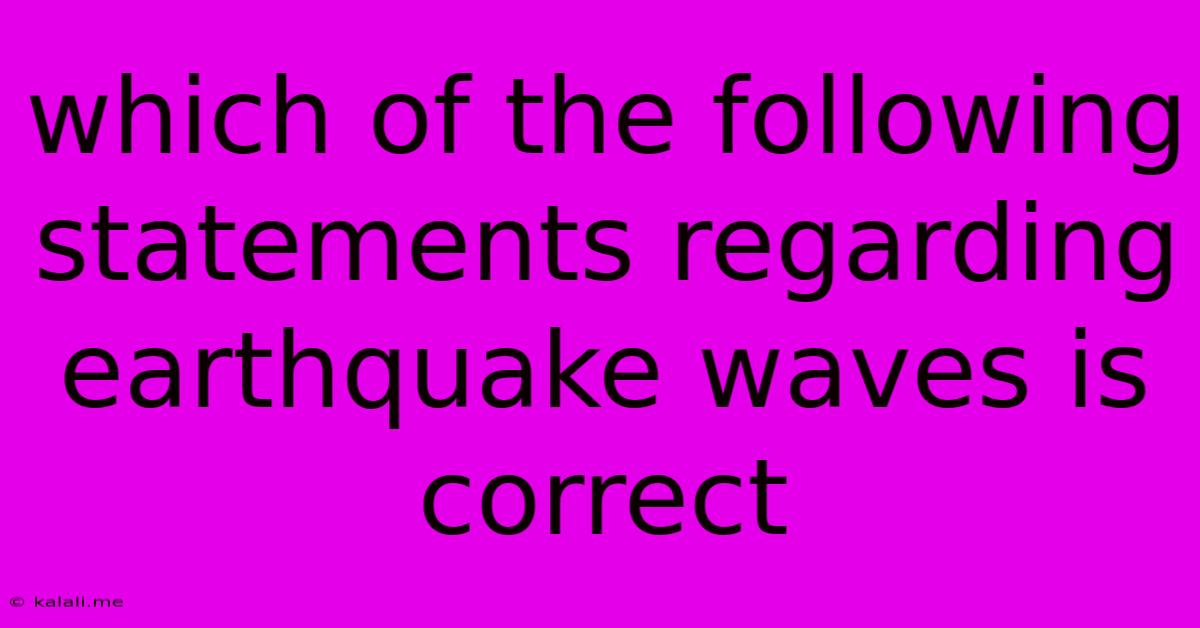Which Of The Following Statements Regarding Earthquake Waves Is Correct
Kalali
Jun 14, 2025 · 3 min read

Table of Contents
Which of the Following Statements Regarding Earthquake Waves is Correct? Understanding Seismic Waves
Earthquakes, those powerful tremors that shake the ground beneath our feet, generate waves that travel through the Earth's interior and across its surface. Understanding the characteristics of these seismic waves is crucial for predicting their impact and mitigating earthquake damage. This article will delve into the properties of these waves, clarifying common misconceptions and highlighting the correct statements about their behavior.
Meta Description: This article clarifies common misconceptions about earthquake waves, explaining the differences between P-waves, S-waves, and surface waves, and highlighting their properties. Learn which statements about seismic waves are correct and improve your understanding of seismology.
Types of Earthquake Waves: A Quick Overview
Seismic waves are broadly categorized into two main types: body waves and surface waves. Body waves travel through the Earth's interior, while surface waves travel along its surface. Let's break down the key differences:
-
P-waves (Primary Waves): These are compressional waves, meaning they travel by compressing and expanding the material they pass through. Think of it like a slinky being pushed and pulled. P-waves are the fastest seismic waves, arriving first at seismograph stations. They can travel through solids, liquids, and gases.
-
S-waves (Secondary Waves): These are shear waves, meaning they travel by shearing or moving the material perpendicular to their direction of travel. Imagine shaking a rope up and down; the wave travels along the rope, but the rope itself moves up and down. S-waves are slower than P-waves and can only travel through solids.
-
Surface Waves: These waves travel along the Earth's surface and are generally responsible for the most significant damage during an earthquake. There are two main types of surface waves:
- Love waves: These waves cause horizontal ground motion, like a snake slithering.
- Rayleigh waves: These waves cause both vertical and horizontal ground motion, similar to the rolling motion of ocean waves. They are typically the slowest but most destructive surface waves.
Evaluating Statements about Earthquake Waves
Now, let's address the common statements regarding earthquake waves and determine their accuracy. Without knowing the specific statements you'd like analyzed, I'll provide examples of correct and incorrect statements and explain why:
Correct Statements:
-
"P-waves are faster than S-waves." This is fundamentally true. The different mechanisms of wave propagation (compressional vs. shear) result in differing speeds.
-
"Surface waves cause the most significant ground shaking." The larger amplitude and slower speed of surface waves lead to prolonged and intense ground shaking.
-
"S-waves cannot travel through liquids." This is correct because liquids lack the shear strength necessary for S-wave propagation.
Incorrect Statements:
-
"All seismic waves travel at the same speed." This is false; P-waves, S-waves, and surface waves all travel at different speeds.
-
"P-waves cause more damage than surface waves." While P-waves are the first to arrive, surface waves generally cause significantly more damage due to their larger amplitude and prolonged shaking.
-
"Seismic waves only travel through the Earth's crust." This is incorrect; body waves travel through the Earth's mantle and core as well.
Conclusion: Understanding the Nuances of Seismic Waves
The behavior of seismic waves is complex but crucial for understanding earthquake dynamics. Distinguishing between the different types of waves and their properties is key to interpreting seismograph data and predicting the potential impact of future earthquakes. By understanding the fundamental differences in their speed, propagation mechanisms, and destructive potential, we can better prepare for and mitigate the risks associated with these powerful natural phenomena. Further research into seismology and seismic wave analysis continues to improve our ability to predict and respond to earthquakes effectively.
Latest Posts
Latest Posts
-
Difference In Supply And Quantity Supplied
Jun 14, 2025
-
What Should Be Changed To Make The Following
Jun 14, 2025
-
A Is The Smallest Unit Of Language That Conveys
Jun 14, 2025
-
Which Of The Following Is Not A Nutrient
Jun 14, 2025
-
Which Of The Following Series Converge To 2
Jun 14, 2025
Related Post
Thank you for visiting our website which covers about Which Of The Following Statements Regarding Earthquake Waves Is Correct . We hope the information provided has been useful to you. Feel free to contact us if you have any questions or need further assistance. See you next time and don't miss to bookmark.